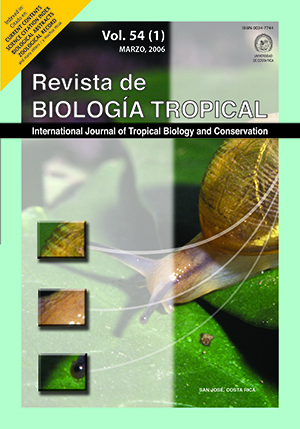Abstract
Costa Rican natural ecosystems are among the most diverse in the world. For this reason, we isolated strains of the entomopathogenic bacteria Bacillus thuringiensis (Bt) to determine their diversity, distribution and abundance. A total of 146 Bt strains were obtained from environmental samples collected from diverse natural ecosystems and life zones of Costa Rica. We recovered Bt strains from 71%, 63%, 61% and 54% of soil samples, fresh leaves, other substrates and leaf litter respectively. Bt was isolated in 65% of the samples collected in the humid tropical forest in national parks (Braulio Carrillo, Gandoca Manzanillo, Sierpe, Hitoy Cerere, and Cahuita), and in 59% of the samples collected in the dry tropical forest (Parque Nacional Marino las Baulas, Palo Verde and Santa Rosa). In the very humid tropical forest (Tortuguero) Bt was isolated in 75% of the samples and in the very humid tropical forest transition perhumid (Carara) it was found in 69% of the samples. The strains exhibit a diverse number, size and morphology of parasporal inclusion bodies: irregular (47%), oval (20%), bipyramidal (3%), bipyramidal and cubic (1%), bipyramidal, oval and irregular (5%) and bipyramidal, oval and cubic crystals (2%). Strains isolated from Braulio Carrillo, Tortuguero and Cahuita, presented predominantly irregular crystals. On the other hand, more than 60% of the isolates from Térraba-Sierpe and Hitoy-Cerere had medium oval crystals. Strains from Gandoca-Manzanillo, Palo Verde and Carara presented mainly combinations of oval and irregular crystals. Nevertheless, the greatest diversity in crystal morphology was observed in those from Santa Rosa, Llanos del Río Medio Queso and Parque Marino las Baulas. Protein analyses of the crystal-spore preparations showed δ-endotoxin with diverse electrophoretic patterns, with molecular weights in the range of 20 to 160 kDa. Fifty six percent of the strains amplified with the cry2 primer, 54% with vip3, 20% with cry1, 9% with cry3-cry7 and 8% with cry8. The cry11 and cyt genes were found in 8% and 7% of the strains, respectively. When analyzed with specific primers for the cry1 subfamily, 13 different genetic profiles were obtained. In addition, twenty-four strains did not amplify with any of the primers used, suggesting they contain novel cry genes. The diversity of Bt genes found in this collection indicates it could have great potential for the control of different species of insect pests. The toxicological characterization of the strains by bioassays against important insect pests will provide useful information about their potential use for the formulation of biological insecticides and their respective cry and vip genes for the transformation of crops to confer resistance to insects.
##plugins.facebook.comentarios##

This work is licensed under a Creative Commons Attribution 4.0 International License.
Copyright (c) 2006 Revista de Biología Tropical






